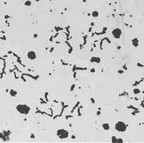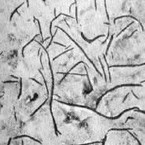
Cast Iron
The fatigue performance of a particular cast iron depends on the quantity, size, and shape of the free graphite constituent as well as its interaction with the matrix. Tensile and compressive behavior of cast iron can be different. Compressive strength and modulus are greater than the tensile strength and modulus. Fatigue analysis of cast iron requires special considerations of this asymmetric stress strain response. Cast irons may be broadly classified into three types: Ductile iron, compacted graphite or grey iron. Each of these types has different stress strain behavior.
Ductile Iron

In fatigue, graphite nodules, under a tensile load, have been observed to debond from the surrounding matrix. Fatigue cracks initiate not only from nodules but also from casting imperfections such as inclusions, microshrinkage pores, and irregularly shaped graphite clusters. These irregularities initiate cracks at an earlier stage in life than well formed nodules. As a result, the quality of the casting will have a large influence on the fatigue life of ductile iron castings. Even at long lives, cracks are observed very early in the lifetime of ductile iron.
Compacted Graphite

Compacted Graphite has a graphite configuration between that of ductile iron and gray iron. The fatigue performance is also between that of ductile and gray iron.
Gray Iron

Graphite in gray iron is highly branched and interconnected within a eutectic cell structure. These cell structures are composed of sharp flakes which provide an easy fracture path as well as areas of high stress concentration. Cracks start on the first loading cycle at flakes oriented perpendicular to the applied tensile stress. Since grey iron already contains cracks, it is not very notch sensitive.
Fatigue Analyzers
Sign in or sign up to use these analyzers
Finders
Sign in or sign up to use these materials
 日本語
日本語